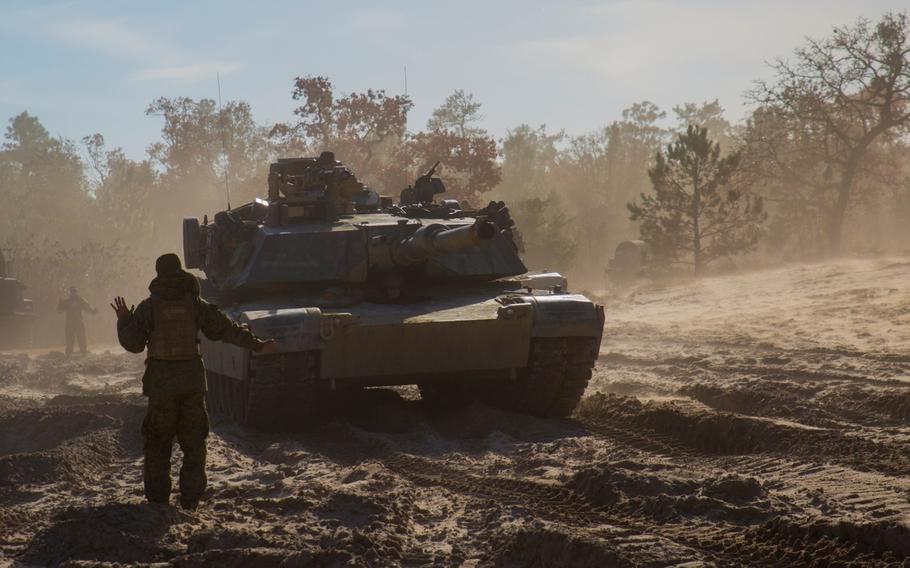
Cpl. Jose Peralta, a Marine with Company B, 2nd Tank Battalion, 2nd Marine Division, II Marine Expeditionary Force, guides a tank into a lane after conducting breaching exercises aboard Marine Corps Base Camp Lejeune, N.C, on Dec. 8, 2014. Marines with the II MEF will help form the Combined Arms Company, which will train with Bulgarian forces starting in September. (Preston McDonald/U.S. Marine Corps)
NAPLES, Italy — The Marine Corps is preparing to deploy a company-size unit equipped with tanks, armored vehicles and artillery to Bulgaria, an expansion of its Black Sea footprint meant to reassure allies and add new crisis-response options.
The first rotation of the Combined Arms Company will bring 150 Marines to the Novo Selo Training Area, Bulgaria, in September. Accompanying the unit will be four Abrams tanks, six Light Armored Vehicles and three howitzers, said Brig. Gen. Norm Cooling, deputy commander of Marine Forces Europe-Africa.
Current plans call for three consecutive six-month rotations, Cooling said, though the presence could be extended with additional funding.
The new unit will incorporate armor and heavy weapons into training the Marines already conduct with local armed forces around the Black Sea. It provides an armor element to the Marines’ crisis-response force in Moron, Spain, Cooling said.
“It will give us the opportunity to train with our NATO allies in ways we have not been able to do so far because we have not had armor,” he said.
The move is part of the broader American effort to support eastern European allies unnerved by Russia’s annexation of Ukraine’s Crimea Peninsula last year, its continued support for separatists in eastern Ukraine and Moscow’s growing assertiveness at sea and in air.
The unit’s deployment resembles the Army push to pre-position heavy weaponry at sites in six east European countries. Those plans call for the placement of 250 Abrams tanks, Bradley fighting vehicles and artillery in Poland, Romania, Bulgaria and the three Baltic nations.
The Marine company will be attached to a battalion-size Marine unit at Mihail Kogalniceanu Air Base in Romania. That unit, of about 550 Marines, includes the Black Sea Rotational Force that currently trains with regional militaries.
Marines rotating to the new Combined Arms Company will come from II Marine Expeditionary Force, out of Camp Lejeune, N.C. Funding comes through the European Reassurance Initiative, a roughly $1 billion account aimed at bulking up U.S. presence and exercises in Europe.
The company’s first task will be moving its vehicles and equipment from port in Bremerhaven, Germany, down the Continent to Bulgaria — no small logistical feat, according to Cooling.
“Anytime you’re taking forces from the United States and moving them to Europe, especially heavy forces, that is an event in of itself,” he said. “That is a training objective.”
Marine leaders have established several rotational ground-based units in Europe and the Middle East in recent years, each tailored to training or crisis response. The larger units, known as air-ground task forces, incorporate aircraft like the Harrier jet and MV-22 Osprey, as well as artillery and rifle companies.
The Corps prefers operating from U.S. Navy amphibious warships. But a high demand for those vessels, a lack of new shipbuilding in recent years and concerns over crisis hot spots in regions like North Africa has Marine leaders considering other options.
Those options include the use of tanker-style cargo ships for small Marine detachments and even the warships of several allied nations.
beardsley.steven@stripes.com Twitter: @sjbeardsley